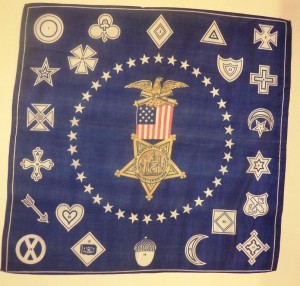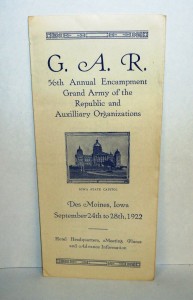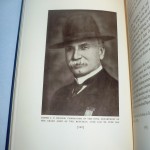
Today’s post comes from Jacque Roethler on Grand Army of the Republic finds in her recent processing work.
Special Collections recently acquired the papers of a law firm in Cedar Rapids, the Bealer/Grimm/Shuttleworth papers. In it were the expected files on cases, insurance, and property, but in a ledger containing E. J. C. Bealer’s 1927 expenses I came across this GAR handkerchief. Curious, I determined to find out more about the Grand Army of the Republic in Iowa.
The GAR was a fraternal order open to honorably discharged soldiers of the Union Army. The first post of the GAR was founded in Decatur Illinois in April 1866. By the end of October, an Iowa post had been organized, among the first in the nation. Though it started strong, the Iowa Department, following a national trend, lost membership in the early years, probably because the men were trying to secure a livelihood and starting (or continuing) families and certainly because they could not sort themselves out politically, especially in light of Reconstruction in the South. In January 1871 the Iowa Post was dissolved. In 1872 the national organization made an effort to re-start the Iowa program, and an Iowa Department was re-established. It remained small but the officers were determined that it not be abandoned again.

The Grand Army of the Republic reached its peak in 1890, when it had a national membership of 490,000. Iowa reached its peak then, too, with 435 posts and a membership of 20,234. After this time the number of posts remained constant for years, but overall membership declined. The national GAR was finally dissolved in 1956, when its last member died.
Though at their inception the membership decided that they were not going to a political group, the GAR was one of the first advocacy groups in America. They advocated for voting rights for black veterans. In Iowa, it was largely due to the influence of the GAR that the Soldier’s Home in Marshalltown was built after the legislature appropriated $100,000 in 1886 for the purpose. In 1889 the legislature authorized the Soldier’s Relief Fund. In 1904, encouraged by the GAR, the legislature gave veterans preference in public employment, though by this time most of the veterans had aged out of the work force.

Monuments to the Civil War dead were also a priority for the Iowa GAR and they lobbied for state funding for monuments in Des Moines and Vicksburg. The GAR got the General Assembly to finance a roster of every living veteran in the state of Iowa. The GAR was so powerful that that Iowa government gave them a room in the state capitol to be used as a permanent headquarters, for which the state appropriated funds for maintenance. The Iowa GAR was instrumental in seeing that almost all of the schools in Iowa had a flag to raise every morning and the Woman’s Relief Corps (the women’s auxiliary to the GAR) had placed in every school in Iowa a pamphlet about the management and care of flags.
The national meetings, which took place once a year, were called National Encampments. In 1922 the 56th National Encampment was held in Des Moines. Twenty thousand veterans and their allied organizations were in attendance. The average age of attendees was around eighty. At this Encampment, Judge James W. Willet of Tama, Iowa, was elected unanimously as the Commander-in-Chief of the Grand Army of the Republic.

E.J.C. Bealer was elected to the Iowa Legislature in 1901 and served three terms, and he supported legislation of interest to veterans, including the Vicksburg Monument. He served as Commander of the Iowa Department of the Grand Army of the Republic from June 1918 to June 1919. He attended the National Encampment in Des Moines in 1922. In the collection you can find reservations at the Hotel Savery, where he stayed during the Encampment. We have a campaign brochure for Willet, sent to Bealer in an envelope addressed to “Comrade E.J.C. Bealer, Past Department Commander GAR.” And we have this wonderful GAR handkerchief seen above. The image in the center of the handkerchief is the badge of the GAR. The icons surrounding the central badge are the corps badges.